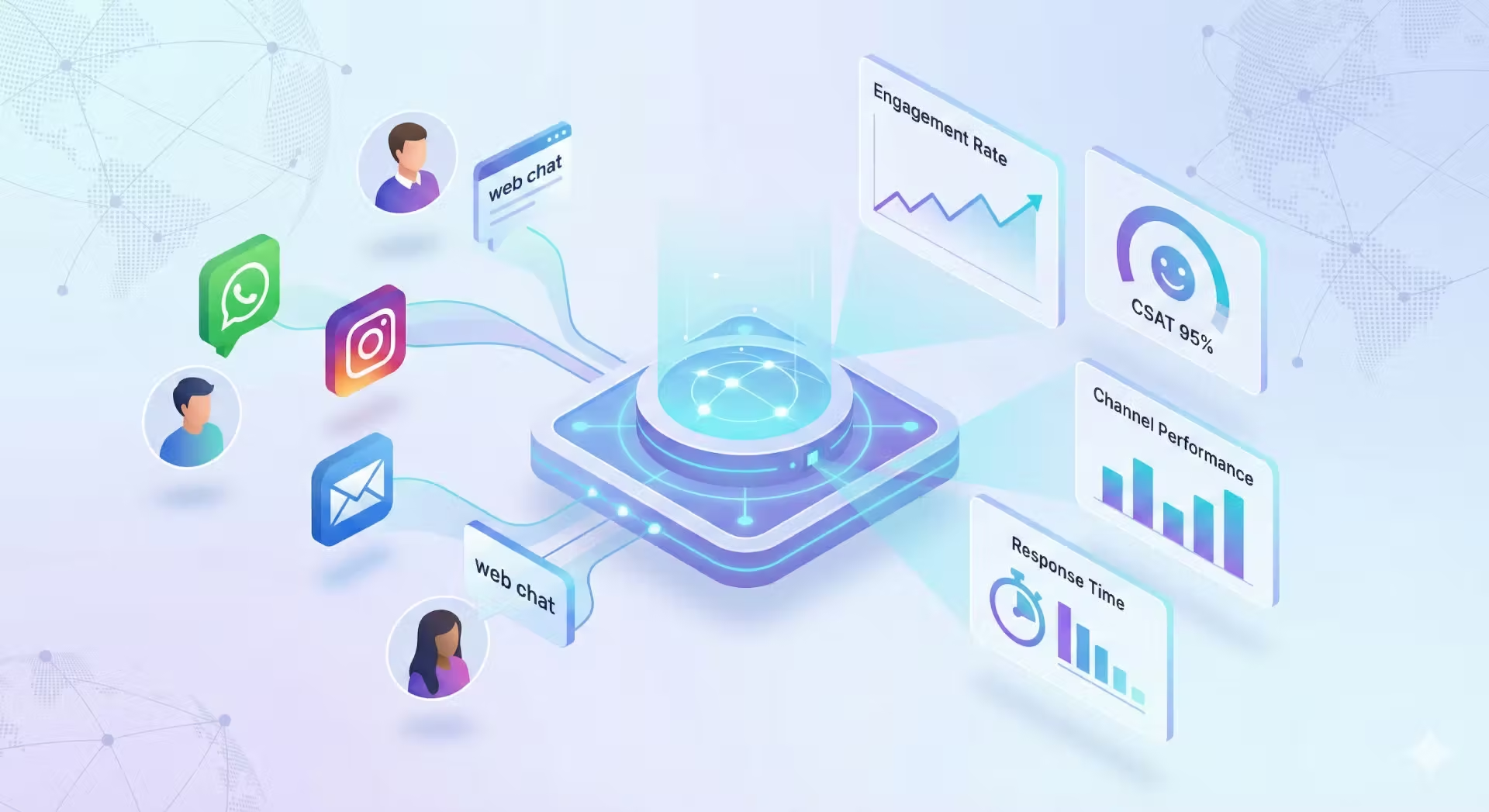Imagine having a broken car on a busy highway during rush hour. You needed to make it to your workplace in less than half an hour, but now you are late, alone, and stranded. Your only hope is a quick response from a roadside assistance service you are about to call.
What happens if their customer service agents are unavailable? Or worse, they are available, but their response time is too slow to provide support within your limited time frame. I bet you’ll be looking at alternative services next time, right?
That’s how crucial real-time customer support can be for customer satisfaction.
But what is real-time customer support, and why is it the backbone of customer service in several time-sensitive industries? This blog post will answer all your questions… in real time! 😉
Understanding real-time customer support
Real-time customer support refers to providing immediate assistance and solutions to customers in real-time, often through various communication channels such as Live Chat, phone calls, or messaging platforms. It involves delivering instant responses to customer inquiries, issues, or requests as they occur, without delay or waiting periods.
💡What is real-time advice? Real-time advice in customer service refers to instant guidance provided to customers during their interaction with a support agent, helping resolve issues promptly and enhance overall satisfaction.
But do you know why is real-time support important? According to a survey by Statista, 12% of Americans cited “lack of speed” as their main cause of customer service frustration.
Real-time customer support is always about quality
Although it sounds like this is just about speed, it’s actually about being there for customers and servicing quality. Because frustrate a customer enough, and you likely won’t hear back from them.
Furthermore, when a customer contacts a business through their social media channel for customer support, 32% expect a response in as little as 30 minutes, while 42% can wait for an hour.
Real-time customer support per industry
But the above statistics are a bit more general. Ideal response times are heavily influenced by the industry you operate in. Here’s a quick rundown of the importance of real-time customer support for the following major industries:
- Automotive:
In the automotive industry, quick response time is essential for addressing urgent vehicle issues and ensuring customer safety. Rapid-response customer help allows automotive service providers to offer immediate assistance for roadside emergencies, vehicle breakdowns, and maintenance inquiries. Rapid response helps minimise customer inconvenience and fosters trust in the brand's reliability and commitment to customer care.
- Travel & Leisure:
Travel disruptions, flight cancellations, booking inquiries, and itinerary changes… you almost can’t run a travel and leisure business if you cannot provide quick and 24/7 customer support. Real-time customer support enables airlines, hotels, and travel agencies to promptly assist travellers with rebooking flights, resolving issues, and providing updates on travel arrangements.
- Hospitality:
Real-time customer support allows hotels, resorts, and accommodation providers to promptly assist guests with room requests, maintenance issues, dining reservations, and special requests.
Benefits of real-time customer support
Having a solid customer care system in place works wonders for your business. And it becomes even better when your support agents can complete the job within minutes. Here are a few benefits of providing real-time customer support:
1. Improved customer satisfaction
According to a survey, 30% of the respondents think that the most frustrating part of customer service is not being able to reach an agent for live support.
Being able to be there for your customers and solve their queries greatly improves your odds of nailing customer satisfaction.
2. Increased customer retention
Here’s a statistic to put the importance of customer retention into perspective: as little as a 5% increase in customer retention can boost your company’s by 25% to 95%, says Bain.
But how do you retain these customers? By staying helpful! Offering on-the-spot support remains a crucial factor in helping to maintain brand loyalty and turn one-time shoppers into trusting regulars.
3. Enhanced brand reputation
When you provide accurate, real-time customer care, buyers start seeing your brand as reliable and trustworthy.
According to Microsoft, 74% of millennials have stated that they view a brand more positively when they see the company actively engaging with customers' social media queries.
Strategies for implementing real-time customer support
The question you should be asking yourself here is: how do I offer 24/7 customer support?
Here are the best strategies that’ll help you implement real-time customer support effectively:
1. Invest in the right technology
In the modern business landscape, it is simply not possible to win the real-time customer care game without employing the right tools and software.
You’ll need to handle several fronts like chatbots for AI-powered care, Live Chat for more complex queries, emails, real-time customer support numbers, and social media channels. For businesses operating beyond borders, a customer support real-time translation feature is also necessary for providing instant support to customers worldwide.
You’ll need to offer assistance through multiple channels and keep your responses quick, while not losing customer service best practices like personalisation, a suitable tone of voice, and access to customer history.
💡And that is where a customer service tool like Trengo comes in. With its ability to bring all your customer care channels under one roof and employ support tactics like automated responses, agent collaboration, and performance analytics, Trengo ensures that you stay on top of your real-time customer support.
2. Train your teams and support agents
With customer service trends constantly changing, your teams and support agents must be adequately trained and equipped to provide instantaneous customer care. Keep them up-to-date with new tools and new support channels.
It is also necessary that your team be well-informed about the concepts of tone of voice in customer service to ensure that your customers have a pleasant experience while contacting your business.
3. Setting up proactive support systems
What’s quicker than solving your customers’ problems even before they arise? Proactive support systems are an integral component of real-time customer support and include self-help services like a resource hub, FAQ section, and a self-help online forum.
For example, Trengo has a Help Centre on its website to help its customers get answers to their common questions:

What to track once you’ve started real-time customer support?
Are you providing instantaneous assistance to your customers? Here are the metrics that’ll tell you if you’re doing it right:
- Response time: This measures how quickly a customer inquiry is acknowledged and responded to by a support agent. It reflects the efficiency and responsiveness of the support team.
- First response time (FRT): FRT measures the time it takes for a support agent to send the first meaningful response to a customer query. It indicates how promptly customers receive initial assistance.
- Resolution time: This metric tracks the time taken to resolve a customer issue from the moment it is reported until it is completely resolved. A shorter resolution time indicates efficient problem-solving.
- Customer satisfaction (CSAT) score: CSAT measures the level of satisfaction among customers after interacting with support agents. It is typically measured through surveys or feedback forms and provides valuable insights into customer perceptions of the support experience.
- First contact resolution (FCR) rate: FCR measures the percentage of customer inquiries that are resolved during the first interaction with support, without the need for follow-up contacts. A high FCR rate indicates effective problem-solving and minimises customer effort.
- Customer effort score (CES): CES measures the ease with which customers can resolve their issues with the support provided. It assesses the level of effort required from the customer's perspective and helps identify areas for improvement in the support process.
- Ticket volume: Tracking the volume of incoming support tickets over time helps identify trends and patterns in customer issues. It enables support teams to allocate resources effectively and prioritise tasks based on workload.
- Channel utilisation: This metric tracks the distribution of customer inquiries across different support channels such as live chat, phone, email, or social media. It helps identify which channels are most commonly used by customers and where resources should be allocated.
- Agent performance: Agent performance measures the productivity and efficiency of support agents by tracking metrics such as average handling time, number of tickets resolved, and idle time. It helps optimise staffing levels and workload distribution.
- Quality assurance (QA) score: The QA score assesses the quality of interactions between support agents and customers based on predefined criteria such as adherence to scripts, professionalism, accuracy of information provided, and resolution effectiveness. Want to know how you can implement quality assurance? Read on about mastering quality assurance for your service.
By tracking these key metrics, businesses can gain valuable insights into the performance of their real-time customer support operations and make data-driven decisions to enhance the customer experience.
How do others do it: success stories
Ferryscanner closes a 700% increase in customer inquiries within 24 hours:
Ferryscanner is a global ferry-booking business operating from Athens, Greece. Summer months, as you can expect, are their most hectic ones.
Their customer success supervisor, Alvertos Iskinatzis, struggled with managing several social media platforms because delivering care through each one was difficult and expensive.
That’s when they decided to switch to Trengo.
Trengo helped them get on top of WhatsApp, Facebook Messenger, email, live chat, and Google's Business Messages all under one roof. The agents were able to collaborate with as little as a tag instead of walking down to each other’s desks. The repetitive task of asking each customer about their booking code was automated through a Flowbot, and agents were able to provide real-time customer support and close inquiries within 24 hours.

Nubikk replies to each chat message within 5 minutes:
Nubikk is a Dutch brand that makes luxury and comfortable shoes affordable. A few years ago, their customer service team monitored their emails, real-time customer support numbers, live chat, and social media platforms individually. Needless to say, as the company grew, this cost them a lot of time and confusion.
Nubikk partnered with Trengo because of their omnichannel support platform. All their customer queries can be answered through one tool while also having access to each chat’s context to avoid confusion.
They used pre-written quick replies to answer straightforward questions, decreased their response time to 5 minutes by prioritising live chat queries, and were even able to streamline their agents working from home.
Let’s not forget, real-time customer support challenges and solutions
Real-time customer support brings its fair share of challenges, but with the right strategies, you can navigate them smoothly. Here is a quick summary of a few common challenges and their suitable solutions:
1. Managing high volumes of inquiries
One common hurdle with real-time customer care is managing the influx of incoming queries, especially during peak times.
✅Solution:
- Consider implementing automated chatbots to handle basic inquiries, freeing up human agents to focus on more complex issues.
- Prioritize inquiries based on urgency and complexity to ensure timely responses to critical matters.
2. Consistency across channels
Maintaining consistency across channels is another challenge, as customers expect a seamless experience whether they're reaching out via chat, phone, or social media.
✅Solution:
- Standardise responses and protocols across all communication channels
- Ensure that agents are equipped with up-to-date information and trained to provide consistent support regardless of the platform.
3. Personalisation
When you aim to close each query within minutes, it gets hard to access previous customer records and offer personalised assistance.
✅Solution:
Invest in an integrated support platform, like Trengo, that consolidates all customer interactions and data in one place. This enables agents to access relevant information quickly, streamline communication, and provide personalised assistance across channels.
4. Consistent quality and branding
Ensuring that your agents are abiding by your brand’s tone of voice and personality while managing hundreds of queries every day can be a challenge.
✅Solution:
Regular training and performance evaluations play a crucial role in maintaining consistency and ensuring that agents uphold the brand's voice and values in every interaction.
Why does real-time customer support make your customers happy?
Gone are the days when accuracy and politeness were the only two factors that determined the success of your customer service. With the advent of smartphones and social media, it’s quality at speed that is gaining ground.
Real-time customer support means being there for your customers, always and through every platform. Businesses that prioritise swift customer care not only get to increase their brand loyalty but also boost their net profits by improving customer retention.
Are you ready to take your customer service a notch up and start helping in real time?




.png)











